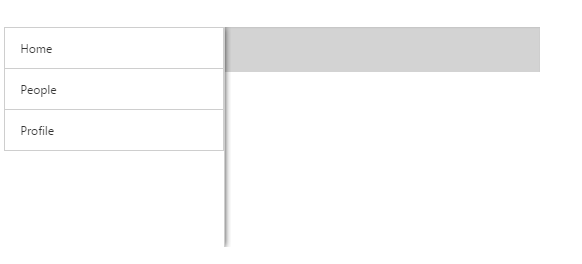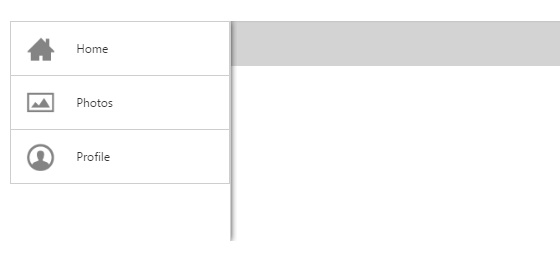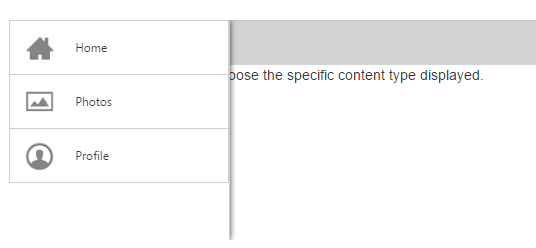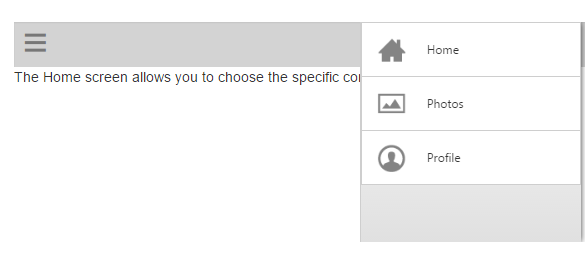Getting Started with ReactJS Navigation Drawer
12 May 202216 minutes to read
This section helps to get started with Essential ReactJS Navigation Drawer component.
Create a Navigation Drawer
Refer the common ReactJS Getting Started Documentation to create an application and add necessary scripts and styles for rendering our ReactJS components.
Create a JSX file and use
ReactDOM.render(
<EJ.NavigationDrawer id="navpanedefault"
</EJ.NavigationDrawer>,
document.getElementById('navigation')
);Define an HTML element for adding Navigation Drawer in the application and refer the JSX file created.
<div id="navigation"></div>
<script type="text/babel" src="sample.jsx">Configuring properties
In the JSX, need to declare the navigation drawer properties. Refer to the following code,
ReactDOM.render(
<EJ.NavigationDrawer id="navpanedefault" type="overlay" direction="left" enableListView={true} listViewSettings-width={220} listViewSettings-height="100%"
listViewSettings-selectedItemIndex="0" position="normal">
<ul>
<li data-ej-text="Home"></li>
<li data-ej-text="People"></li>
<li data-ej-text="Profile"></li>
</ul>
</EJ.NavigationDrawer>,
document.getElementById('navigation')
);Create the target element as follows to display the list items by clicking target icon.
<div id="targetPane">
<div className="e-lv">
<div className="e-header">
<div id="drawer" className="drawerIcon e-icon alignText"></div>
</div>
</div>
</div>To set the target icon image and with the correct position as using the below mentioned styles.
<style>
.drawerIcon {
background-position: center center;
background-repeat: no-repeat;
height: 45px;
width: 32px;
background-size: 100% 100%;
padding-right: 10px;
}
.drawerIcon:before {
content: "\e76b";
font-size: 24px;
height: 26px;
line-height: 24px;
}
#targetPane {
height: 220px;
position: relative;
padding: 0px;
overflow: hidden;
margin: 0px;
}
</style>
You can open the list items by clicking on target element using the targetId property.
ReactDOM.render(
<EJ.NavigationDrawer id="navpanedefault" type="overlay" direction="left" targetId="drawer" enableListView={true} listViewSettings-width={220} listViewSettings-height="100%"
listViewSettings-selectedItemIndex="0" position="normal">
<ul>
<li data-ej-text="Home"></li>
<li data-ej-text="People"></li>
<li data-ej-text="Profile"></li>
</ul>
</EJ.NavigationDrawer>,
document.getElementById('navigation')
);
To set the images for list items of the Navigation Drawer by using the [data-ej-imageclass] property as follows.
ReactDOM.render(
<EJ.NavigationDrawer id="navpanedefault" type="overlay" direction="left" targetId="drawer" enableListView={true} listViewSettings-width={220} listViewSettings-height="100%"
listViewSettings-selectedItemIndex="0" position="normal">
<ul>
<li data-ej-imageclass="e-icon e-home" data-ej-text="Home"></li>
<li data-ej-imageclass="e-icon e-photo" data-ej-text="Photos"></li>
<li data-ej-imageclass="e-icon e-profile" data-ej-text="Profile"></li>
</ul>
</EJ.NavigationDrawer>,
document.getElementById('navigation')
);To set the images with the correct position by using the mentioned styles.
<style>
@font-face {
font-family: 'ej-font';
src: url('../../common-images/tools/icons.eot');
src: url('../../common-images/tools/icons.eot') format('embedded-opentype'), url('../../common-images/tools/icons.woff') format('woff'),url('../../common-images/tools/icons.woff') format('woff'), url('../../common-images/tools/icons.ttf') format('truetype'), url('../../common-images/tools/icons.svg') format('svg');
font-weight: normal;
font-style: normal;
}
.e-home:before {
font-family: "ej-font";
content: "\e900";
}
.e-profile:before {
font-family: "ej-font";
content: "\e901";
}
.e-photo:before {
font-family: "ej-font";
content: "\e903";
}
.e-location:before {
font-family: "ej-font";
content: "\e905";
}
.e-people:before {
font-family: "ej-font";
content: "\e902";
}
.e-communities:before {
font-family: "ej-font";
content: "\e904";
}
.e-home, .e-profile, .e-people, .e-photo, .e-communities, .e-location {
font-size: 24px;
color: black;
}
</style>
To add desired page content while selecting the options in navigation drawer as follows.
<!-- Home Page Content-->
<div id="Home">
The Home screen allows you to choose the specific content type displayed.
</div>
<!-- Profile Page Content-->
<div id="Profile" style="display: none">
The Profile page content is displayed.
</div>
<!-- Photos Page Content-->
<div id="Photos" style="display: none">
The Photos page content is displayed.
</div>To load the appropriate content for the navigation by using the listViewSettings-mouseUp event handler of ListView component.
ReactDOM.render(
<EJ.NavigationDrawer id="navpanedefault" type="overlay" direction="left" targetId="drawer" enableListView={true} listViewSettings-width={220} listViewSettings-height="100%"
listViewSettings-selectedItemIndex="0" listViewSettings-mouseUp={this.headChange} position="normal">
<ul>
<li data-ej-imageclass="e-icon e-home" data-ej-text="Home"></li>
<li data-ej-imageclass="e-icon e-photo" data-ej-text="Photos"></li>
<li data-ej-imageclass="e-icon e-profile" data-ej-text="Profile"></li>
</ul>
</EJ.NavigationDrawer>,
document.getElementById('navigation')
);In the mouse, up handler, it’s display the respective selected item’s content.
headChange: function (e) {
$('#Home, #Profile, #Photos').hide(); //Hiding all other contents
$('#' + e.text).show(); //Displaying the content based on the text of item selected
}Run the above code to render the following output.

Customize Direction
By using direction property, to change the list view open direction. The possible directions are Right, Left and the Left is default value.
ReactDOM.render(
<EJ.NavigationDrawer id="navpanedefault" type="overlay" direction="right" targetId="drawer" enableListView={true} listViewSettings-width={220} listViewSettings-height="100%"
listViewSettings-selectedItemIndex="0" listViewSettings-mouseUp={this.headChange} position="normal">
<ul>
<li data-ej-imageclass="e-icon e-home" data-ej-text="Home"></li>
<li data-ej-imageclass="e-icon e-photo" data-ej-text="Photos"></li>
<li data-ej-imageclass="e-icon e-profile" data-ej-text="Profile"></li>
</ul>
</EJ.NavigationDrawer>,
document.getElementById('navigation')
);
NOTE
To get the complete API list for all the Syncfusion component’s properties from the API reference